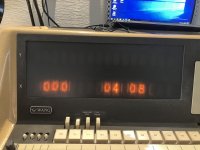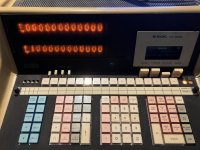
This is what the learn screen looks like. The first tube is not on (this has the + and - signs in it) then 3 digits on for the PC. 4 off. 2 on 1 off 2 on for the instruction and then 3 off I think. And ofcourse, the Y register is off completly.

Set PC screen (with 2 digits of the 3 typed in). It starts of with just the + sign on the left lit. Once the 3rd digit is pressed the machine jumps to than PC right away.

I hope I understood this correctly. I used both the toggle/top row method and the normal key presses.
Starting by pressing (or toggle/toprow) STORE DIRECT and then pressing "+" "1" "0" "0" and "GO"
The X register shows a flashing "+" and 100.0000000000 and the Prog. Error light comes on.
I hope that answers the question...
On digitising the tapes... it's going to be a bit difficult I think. After a few hours of playing around with various settings in Audacity and also trying different ways to get the audio from the tapes into Audacity (including using the digitiser on batteries and playing the audio into the microphone port of the laptop) I've come to the conclusion that the digitiser is a cheap piece of crap.... but, it does work.
One of the last things I tried was to change the playback speed of the recording. And if I set the playback to just the right channel, at the correct volume, inverted AND at 1.24 times playback speed.... I can load my 200 zero's back into memory using the recording from my testtape and the tape adaptor in the drive of the 700B.
So... either the tapedeck in the 700B has a different speed then regular audio cassettes, or the speed of the digitiser is way off. (And given the reviews of this digitiser and other simular ones it can really be either... the playback speeds, wow and flutter of these cheap things can be all over the place).
I do get the feeling that the portion of the 700B that "listens" for the flux changes on my device is not working 100%... probably more like 95% or something. Because every now and then it just doesn't want to load anything. Or just load garbage data. Especially if I'm doing tests in quick succesion. And after a while, it will work again, almost as if some semiconducter warms up and goes out of spec or something.
Still, it DID eventually work.




